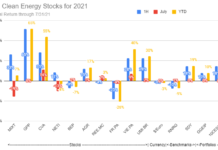Last week I was speaking to Jim Atkinson of Guinness Atkinson Funds (or GA Funds) (see Disclosure below). Jim sent me document or research paper called, “The Alternative Energy Revolution” which was written in April 2006. The document is usually accompanied by a prospectus for the GA Alternative Energy Fund. Today, I am not commenting on the fund itself but will summarize some of the information I found important in “The Alternative Energy Revolution” paper. A link to the document itself follows my summary. Please note, I am simply presenting the information and numbers in the document.
Alternative Energy Revolutions Summary
The paper was definitely written from a ‘pro’ alternative energy perspective. It starts out presenting the familiar case that world energy demand is increasing and our oil supply is running out.
Energy Consumption and Oil
The paper gives early on a word of caution about investing in alternative energy. It is a reality that applies to all alternative energy investments: alternative energy investments are largely thinly traded small cap stocks that have had significant recent appreciations due to increased energy prices.
All revenue numbers below are worldwide revenue numbers stated in U.S. dollars. Projections and forecasts cited in the paper were taken from a variety of sources.
Solar Industry
Revenue in 2005 – 11.2 billion
Projected Revenue in 2015 – $51.1 billion
Two parts of solar industry – photovoltaic and thermal
Investment opportunities are mainly in photovoltaic. High cost of high-grade polysilicon required by solar industry keeps solar costs high. Polysilicon shortage forecast until 2008. No major technological breakthroughs expected in solar industry over the next few years.
Wind Industry
Revenue in 2005 – $11 billion
Projected Revenue in 2015 – $48.5 billion
Least expensive of the modern renewable energy sources and comes closest to competing with oil an economic basis.
New materials have increased efficiency and reduced cost but significant further technological advancements are not expected. Improvements expected to come from more efficient manufacturing processes.
Emerging areas in wind technology are off-shore wind power and microturbines for home and small business use.
Hydro
Revenue 2004 – $20 – $25 billion
Cheapest form of electricity over the last 200 years.
Other benefits of water control, flood supply and irrigation. (Granted, many will argue with this statement.)
Obstacles include significant capital investments required and environmental opposition. Substantial opportunity in small hydro (less than 30 megawatts)
Bio-Energy including Bio-Ethanol
Revenue 2004 – $15.7 billion
Cheapest bioethanol fuel is sugarcane in Brazil, followed by corn and sugarbeet in Europe
Bio-ethanols from different sources is competitive with oil at the following prices: Sugarcane when oil is at $30/barrel, corn when oil is at $50/barrel, sugarbeet when oil is at $70/barrel
Biofuel’s biggest problem is not technological – obstacles are tariffs on developing world production and land shortages.
Industry is poised for considerable growth.
Fuel Cells
Revenue in 2005 – 1.2 billion
Projected Revenue in 2015 – 15.1 billion
Devices that convert oxygen and hydrogen into water while making electricity.
Growth in fuel cells will come from portable devices (cameras and MP3 players) and stationary devices.
Fuel cells in vehicles have a long way to go. Must bring down costs dramatically and this is not expected in the near future.
Hydrogen generation must also become less costly and less dependent on oil as the source of hydrogen.
I do recommend having a read of the whole article, you can find it here:
PDF Download: The Alternative Energy Revolution
In reading the size of industry figures above, the following occurred to me. Exxon Mobil profits in 2005 were $36 billion. These of course are profits and not revenue figures as provided above. The worlds largest oil company made more profit than entire alternative energy industries made in revenue.
Disclosure: Guinness Atkinson Funds now sponsors the site through advertising. The advertising banner for GA Funds can currently be seen on the right hand side of the homepage.









Alternative Energy Stocks: The Alternative Energy Revolution – Summary of Industry Sectors
Trend: Revenues from solar and wind power are predicted to quadruple in the next ten years. Brian at Alt Energy Stocks summarizes The Alternative Energy Revolution (April 2006) from GA Funds. Link: Alternative Energy Stocks: The Alternative Energy Revo…